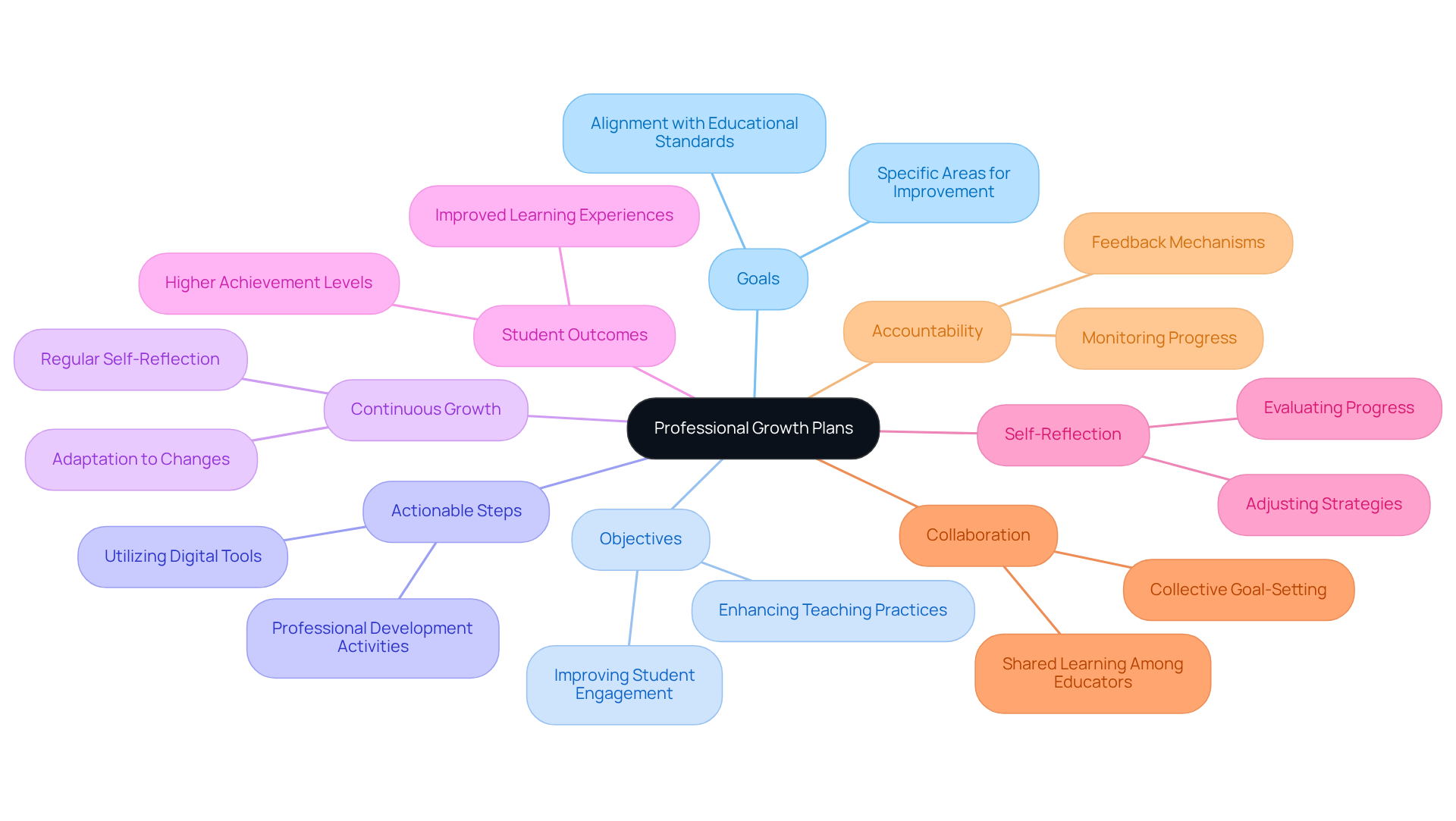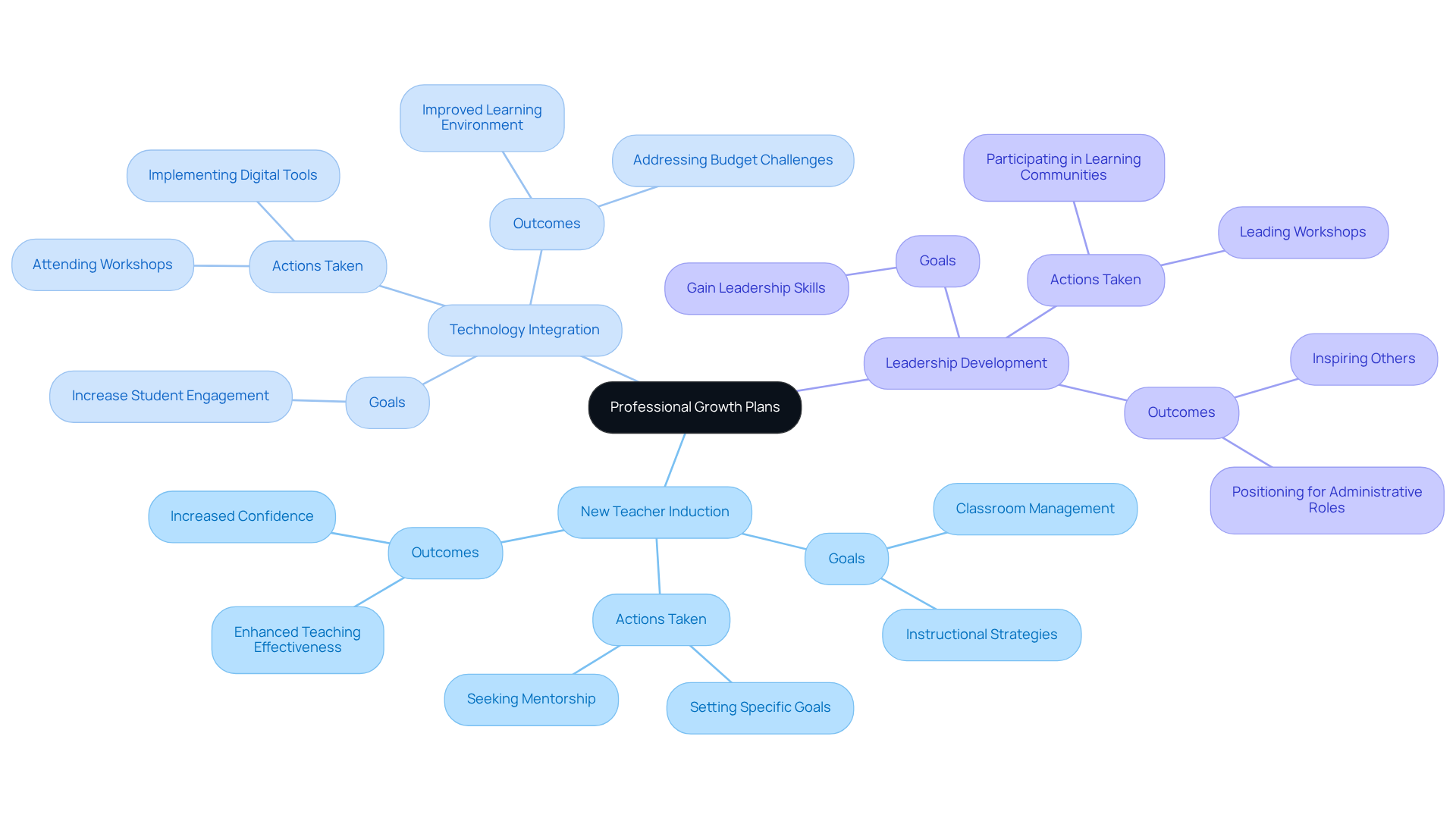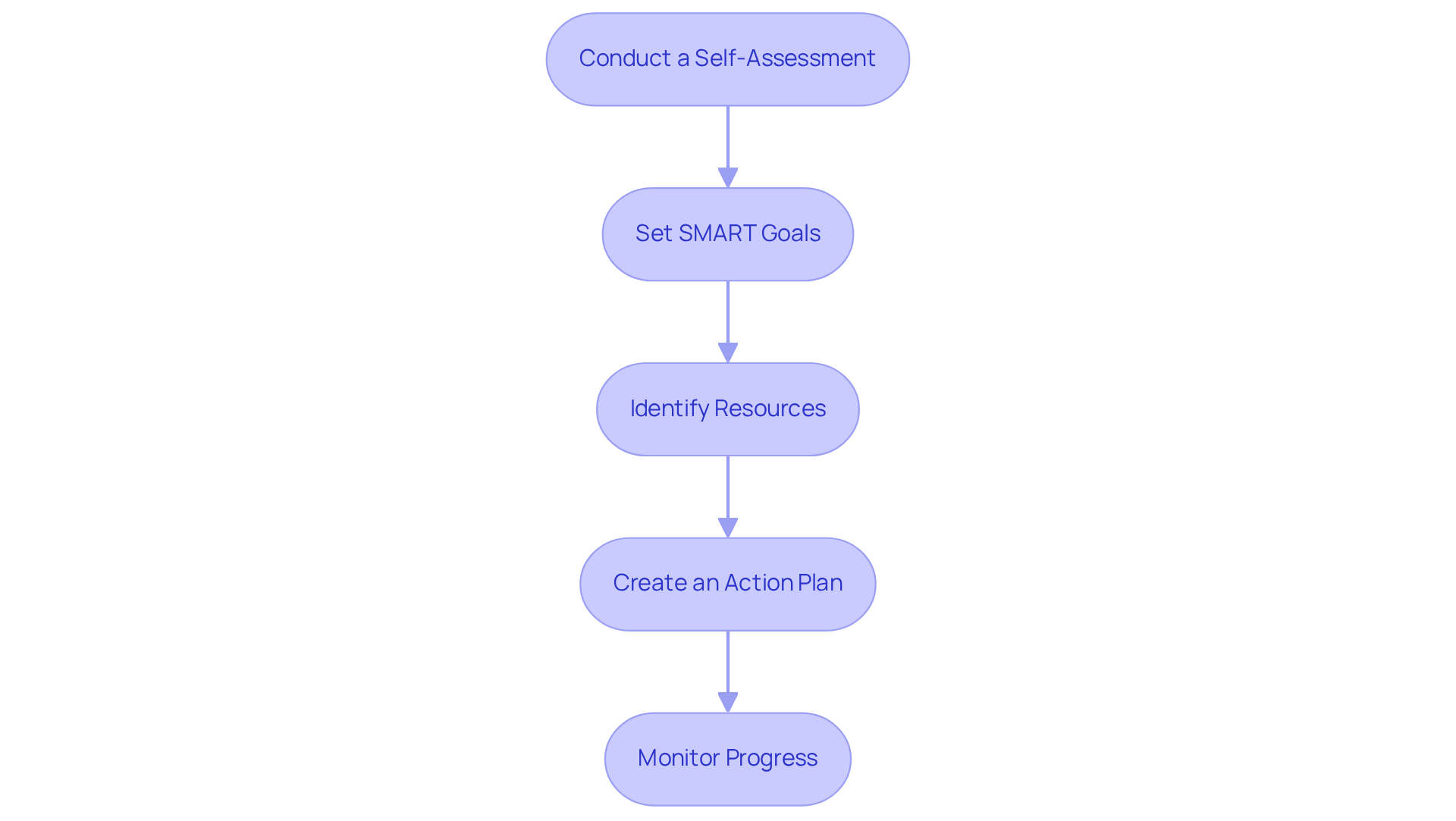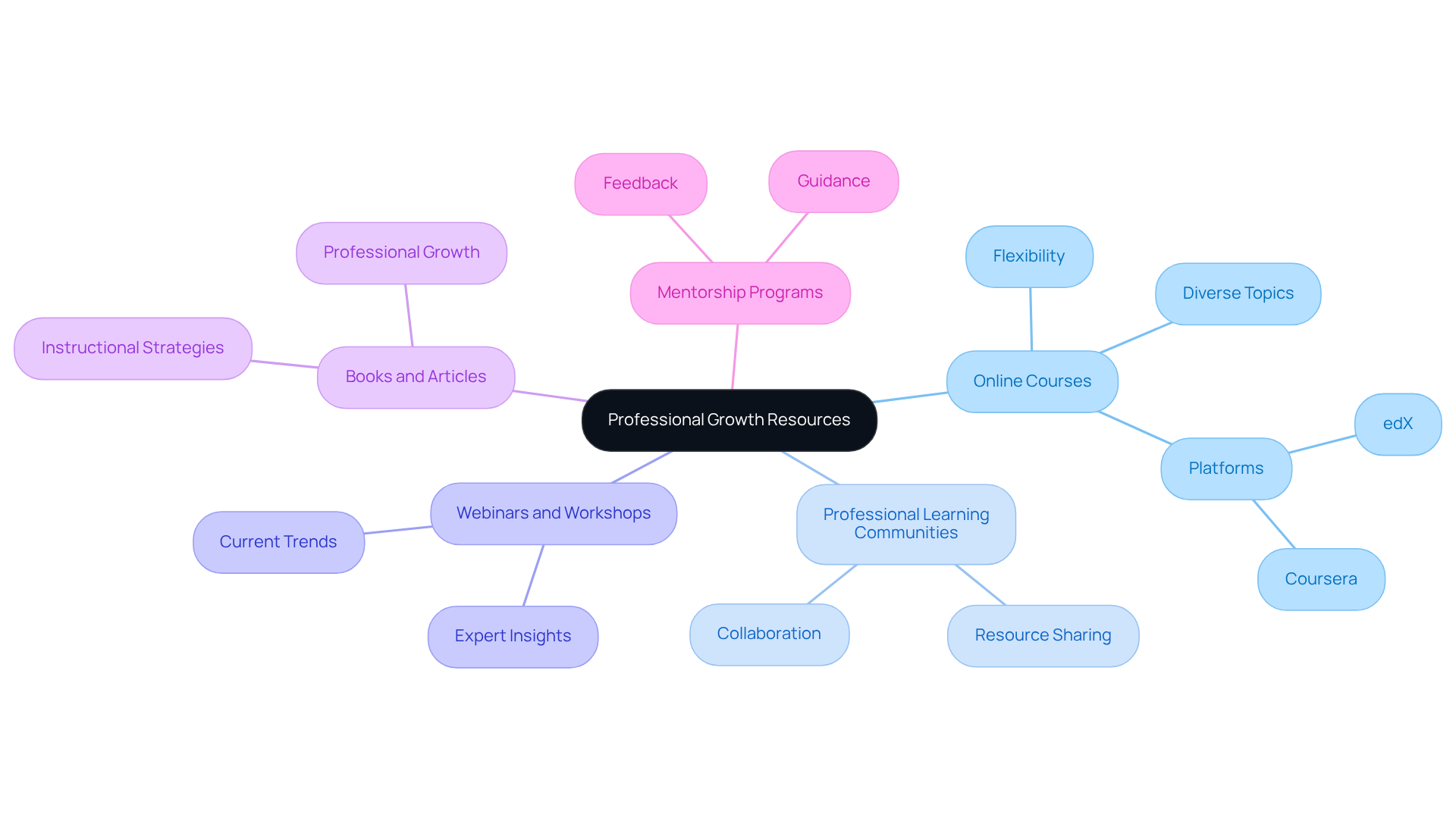Overview
The article highlights a significant challenge faced by educators: the need for continuous growth in an ever-evolving educational landscape. Many educators find themselves struggling to keep pace, which can lead to feelings of stagnation and frustration. This is where a Professional Development Plan (PDP) becomes invaluable. A PDP is not just a document; it is a strategic roadmap that outlines specific goals and actionable steps designed to foster ongoing development and enhance teaching effectiveness.
By encouraging self-reflection and accountability, these plans empower educators to take charge of their professional journeys. They also promote collaboration among peers, creating a supportive community that nurtures growth. Ultimately, this leads to improved student outcomes and meaningful career development.
As you consider the importance of a PDP, think about the potential for transformation it holds—not just for you as an educator, but for your students as well. Embracing this approach can be a powerful step toward navigating the complexities of modern education with confidence and purpose.
Introduction
Creating a professional development plan can often feel like just another bureaucratic task, but it’s so much more than that; it’s a transformative journey for educators who genuinely want to improve their teaching effectiveness. These strategic documents act as essential roadmaps, guiding teachers through their aspirations and the necessary steps to reach them. This journey not only enhances individual teaching practices but also nurtures a culture of continuous improvement within educational environments. Yet, with the pace of change in education today, how can educators ensure their plans stay relevant and impactful? This article will explore the essence of professional development plans, highlighting their significance, real-world applications, and practical steps for crafting effective growth strategies that resonate deeply with both educators and their students.
Define Professional Growth Plans and Their Importance
meaning includes vital strategic documents that outline a teacher's goals, objectives, and the actionable steps needed to achieve them. These plans are essential for , enabling teachers to adapt effectively to the ever-changing educational landscape.
By pinpointing specific areas for improvement, educators can concentrate their efforts on , which directly correlates with . A 2020 Gallup Study highlights that students across all grade levels find digital learning tools enjoyable and beneficial for , emphasizing the critical role of effective teaching practices in utilizing these tools.
Moreover, PGPs embody the by and self-reflection, encouraging teachers to regularly and adjust their strategies as necessary. This ongoing process not only supports individual development but also , ensuring that teachers remain effective and responsive to their students' needs.
As John C. Maxwell wisely states, 'development is the significant divider between those who achieve and those who do not,' which underscores the professional development plan meaning in enhancing teaching effectiveness. Additionally, is crucial, as it nurtures a supportive environment that encourages shared learning and collective goal-setting among educators.

Explore Real-World Scenarios for Professional Growth Plans
Consider the following scenarios where (PGPs) have made a significant impact on educators' journeys:
- New Teacher Induction: A first-year teacher, filled with hopes and uncertainties, develops a PGP that focuses on . By setting , they not only enhance their teaching effectiveness but also build their confidence, creating a positive ripple effect in their classroom.
- Technology Integration: An experienced educator recognizes the growing importance of technology in the learning environment. Their PGP includes attending workshops on and thoughtfully implementing them in the classroom, leading to . A survey of 445 education experts revealed that budget cuts are adversely affecting the learning function in organizations, which underscores the significance of effective PGPs in addressing these challenges and fostering a vibrant learning atmosphere.
- Leadership Development: A dedicated teacher aspires to take on within their school community. Their PGP outlines actionable steps to gain leadership skills, such as participating in learning communities and leading workshops. This proactive approach ultimately positions them for future administrative roles. As John Quincy Adams beautifully stated, "If your actions , learn more, do more and become more, you are a leader."
These situations illustrate the by showing how PGPs can be thoughtfully customized to address individual needs, promoting career development and enhancing educational methods. In our current economic climate, the incorporation of organized career development is vital. Educational initiatives are essential for in customer interactions, ensuring that both educators and students thrive together.

Complete Your Professional Growth Plan: A Step-by-Step Guide
Creating a can feel overwhelming, but it’s an essential step in as an educator. Let’s walk through some key steps together:
- : Take a moment to reflect on your current skills, strengths, and areas for improvement. This personal evaluation is crucial as it helps you pinpoint specific goals for your growth journey.
- Set : Think about defining goals that are Specific, Measurable, Achievable, Relevant, and Time-bound. Instead of saying, "I want to enhance my instruction," consider a more concrete approach: "I will attend three workshops on differentiated instruction by the end of the semester." This clarity can make all the difference.
- Identify Resources: What resources will you need to achieve these goals? This might include , mentorship opportunities, or educational materials that resonate with your learning style.
- : Let’s outline the steps you’ll take to reach your goals, including timelines and milestones. Remember, this plan should be flexible to adapt to any changes in your educational environment, allowing you to grow at your own pace.
- : As you embark on this journey, regularly review your progress towards your goals. It’s important to adjust your plan as necessary based on your experiences and the feedback from those around you.
By following these nurturing steps, teachers can craft impactful plans that embody the [professional development plan meaning](https://snhu.edu/about-us/newsroom/education/personal-growth-quotes), leading to significant advancement and enhancing their teaching methods. You are not alone on this journey; together, we can foster a supportive environment for your growth.

Access Support Materials and Resources for Professional Growth
Embarking on your can feel overwhelming at times. Many educators grapple with balancing their development alongside their teaching responsibilities, often feeling isolated in their . However, there are nurturing resources available to support you along the way.
Consider exploring . Platforms like Coursera and edX provide a diverse range of courses tailored for teachers, focusing on vital topics such as classroom management and . With 85% of online students appreciating the , these platforms empower you to pursue your growth while managing other commitments.
Joining can also be incredibly beneficial. Engaging with local or online groups allows educators to share experiences and resources, fostering a sense of camaraderie. Research shows that participating in these communities significantly enhances , promoting collaboration and ongoing improvement.
Don't overlook . These sessions, often organized by educational institutions, delve into current trends and best practices in instruction. They provide expert insights that can directly improve your teaching effectiveness, making you feel more connected to the broader educational community.
Additionally, consider diving into focused on professional growth and effective instructional strategies. Resources from platforms like Edutopia and the National Education Association offer valuable insights that can enrich your practice and enhance your skills.
Lastly, seek out within your school or district. Connecting with seasoned instructors can provide you with guidance and feedback as you work towards your goals. Research indicates that mentorship often leads to improved teaching methods and greater job satisfaction.
By leveraging these supportive resources, you can enhance your professional development plan meaning and feel well-equipped to meet your development objectives. Remember, you are not alone on this journey; there is a community of educators ready to support you.

Conclusion
Professional development plans (PGPs) are vital for educators, acting as guiding lights in a constantly changing educational landscape. Many educators struggle with the pressures of adapting to new teaching methods and technologies, which can lead to feelings of isolation and uncertainty. PGPs address these challenges by clearly defining specific goals and outlining actionable steps, fostering a culture of accountability and self-reflection. This nurturing approach not only enhances teaching effectiveness but also empowers educators to refine their instructional methods, ultimately benefiting student outcomes.
In this article, we have explored the importance of professional growth plans, sharing key insights and real-world scenarios that illustrate their adaptability to individual needs. Whether it’s supporting new teachers, integrating technology, or developing leadership skills, PGPs can be tailored to meet diverse challenges. Moreover, a step-by-step guide has been provided, offering educators a structured approach to creating their own plans, ensuring they have the resources and support necessary to thrive in their professional journeys.
The journey of professional growth is one that should not be taken alone. By leveraging available resources, participating in learning communities, and seeking mentorship, educators can cultivate an enriching environment that promotes continuous improvement. Embracing the principles of professional development plans is essential, not just for individual educators but for the collective advancement of the educational community. By taking proactive steps towards personal and professional growth, we can inspire both teachers and students to reach greater heights together.
Frequently Asked Questions
What are Professional Growth Plans (PGPs)?
Professional Growth Plans are strategic documents that outline a teacher's goals, objectives, and actionable steps needed to achieve them, fostering continuous growth and adaptation in the educational landscape.
Why are Professional Growth Plans important?
PGPs are important because they help educators identify specific areas for improvement, refine instructional methods, enhance student outcomes, and cultivate a culture of accountability and self-reflection.
How do Professional Growth Plans impact student outcomes?
By concentrating on refining instructional methods through PGPs, educators can improve their teaching effectiveness, which directly correlates with enhanced student outcomes.
What does the 2020 Gallup Study indicate about digital learning tools?
The study indicates that students across all grade levels find digital learning tools enjoyable and beneficial for self-paced learning, highlighting the importance of effective teaching practices in utilizing these tools.
How do Professional Growth Plans promote self-reflection among teachers?
PGPs encourage teachers to regularly evaluate their progress and adjust their strategies as necessary, supporting individual development and aligning with broader educational goals.
What role does collaboration play in creating Professional Growth Plans?
Collaboration in developing PGPs nurtures a supportive environment that encourages shared learning and collective goal-setting among educators.
What is a key quote that emphasizes the importance of development in teaching?
John C. Maxwell states, "development is the significant divider between those who achieve and those who do not," which underscores the importance of Professional Growth Plans in enhancing teaching effectiveness.




